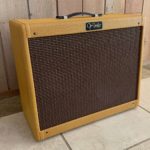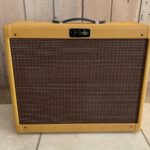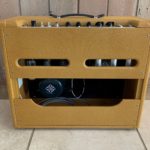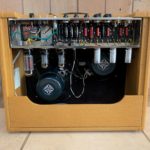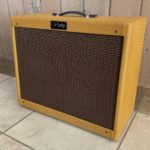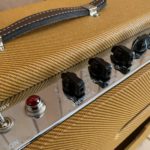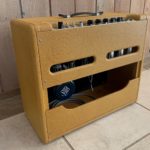5E4 Tweed Super
DESCRIPTION
The 5E4 was a bit of an anomaly in the history of the Super amp. Every other version of the Super used either two 5881 or two 6L6 power tubes for roughly 30 watts of output power. But the 5E4 variant was built around 6V6 tubes to produce an amp with less overall power and headroom. It still came in the same cabinet and still drove a pair of 10″ alnico speakers, but It became more of a mid-sized amp in this configuration. At about 20 watts, it’s closer to the Deluxe, Tremolux and Vibrolux amps in the Fender lineup.
This was an odd choice for Fender because they’d always positioned the Super as a professional level amp with the power, headroom, and features for players performing in front of large audiences. So I guess it’s not a surprise that Fender dropped the 6V6 variant after a little over one year of production; replacing it with the 5F4 in 1956 and returning the Super to the big-boy category with dual 6L6’s and about 30 watts of output power.
But history’s loss is the modern player’s gain. The 5E4 is a nearly perfect tweed amp for the modern player. It features the same classic circuit found in the 5E5 Pro, 5E7 Bandmaster, and 5F4 Super, but combines that circuit with a 6V6 output section running at a modest 390 volts on the plates. The result is glorious tweed tone at a manageable ~20 watts. Lower voltages mean less headroom and the amp can be pushed into delicious distortion at something less than ear-splitting volume. It’s still loud, mind you, but it’s more of a mid-sized amp better suited to small venues, recording, and home practice.
Since the 5E4 chassis can fit the Pro and Bandmaster cabinets, I’m also able offer this amp in 1×12, 1×15, or even a 3×10 configurations.
There’s a great description and background piece on the 5E4 Super found here:
TOPOLOGY
Two independent 12AY7 channels, each with high and low sensitivity inputs. A second gain stage consisting of one half of a 12AY7, directly coupled to a 12AY7 cathode follower that drives a tone stack with independent treble and bass controls and local negative feedback. One 12AX7 recovery stage connected to global negative feedback with Presence control. A 12AX7 cathodyne phase inverter. Two fixed bias 6V6 power tubes drive two 10″ speakers at about 20 watts.
BASE CONFIGURATION
Weber 10A125 speakers, Mercury Magnetics and Soursound transformers, Jupiter Yellow capacitors, carbon composition resistors.
Base Price $2200
OPTIONS
Speakers
- Weber 10A100 (vintage correct) -$10
- Eminence Legend 1028K -$30
- Fat Jimmy C1025 -$40
- Your preferred speakers TBD
Capacitors
- Sozo Blue -$20
- Jupiter Red +$50
Cabinet
- Aged lacquer finish +$95
